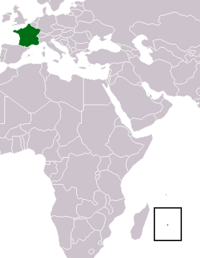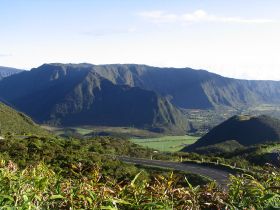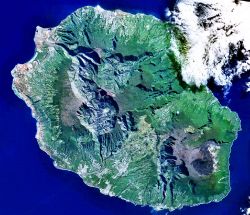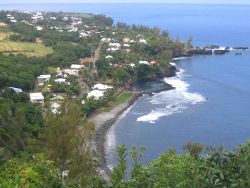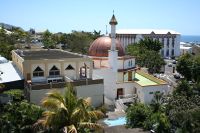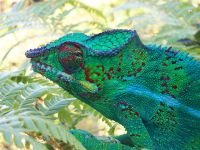Réunion
| Région Réunion | ||
|---|---|---|
|
Logo of Reunion | |
| (Region flag) | (Region logo) | |
| Location | ||
| ||
| Administration | ||
| Capital | Saint-Denis | |
| Regional President | Paul Vergès (PCR) (since 1998) | |
| Departments | Réunion | |
| Arrondissements | 4 | |
| Cantons | 49 | |
| Communes | 24 | |
| Statistics | ||
| Land area1 | 2,512 km² | |
| Population | (Ranked 21st) | |
| - January 1, 2006 est. | 784,000 | |
| - March 8, 1999 census | 706,300 | |
| - Density (2006) | 312/km² | |
| 1 French Land Register data, which exclude lakes, ponds, and glaciers larger than 1 km² (0.386 sq. mi. or 247 acres) as well as the estuaries of rivers | ||
Réunion is an island, located in the Indian Ocean east of Madagascar, about 130 miles (200 km) southwest of Mauritius, the nearest island. Administratively, Réunion is one of the overseas départements of France. Like the others, Réunion is also one of the twenty-six regions of France (being an overseas region) and an integral part of the Republic with the same status as those situated on the European mainland. As an outer region of the European Union, the currency used is the euro.
Geography
The island is 39 miles (63 km) long; 28 miles (45 km) wide; and covers 970 square miles (2512 sq km). Its area is slightly smaller than the U.S. state of Rhode Island. It is similar to the island Hawaii insofar as both are located above hotspots in Earth's crust.
The Piton de la Fournaise, a shield volcano on the eastern end of Réunion Island, rises more than 8,565 feet (2611 m) above sea level and is sometimes called a sister to Hawaiian volcanoes because of the similarity of climate and volcanic nature. It has erupted more than 100 times since 1640 and is under constant monitoring. It most recently erupted on April 4, 2007. The lava flow from this eruption was estimated at about 4 million cubic yards (3 million m3) per day. The Piton de la Fournaise is created by a hotspot volcano, which also created the Piton des Neiges and the islands of Mauritius and Rodrigues.
The Piton des Neiges volcano, the highest point on the island at 10,069 feet (3070 m) above sea level, is northwest of the Piton de la Fournaise. Collapsed calderas and canyons are southwest of the mountain. Like Mauna Kea on the big island of Hawaii, Piton des Neiges is extinct. Despite its name, snow (French: neige) practically never falls on the summit.
The terrain is mostly rugged and mountainous. The slopes of both volcanoes are heavily forested. Cultivated land and cities like the capital city of Saint-Denis are concentrated on the surrounding coastal lowlands.
Réunion also has three calderas: the Cirque de Salazie, the Cirque de Cilaos, and the Cirque de Mafate. The latter is accessible only by foot or helicopter.
Natural resources are fish, arable land, and hydropower.
Climate
The climate is tropical and humid but is influenced by the high mountains. During the hot, rainy summer (December to March) average temperature is 81°F (27°C) on the coast but drops to 64°F (18°C) in the mountains. During winter (April to November), average temperature is 72°F (22°C) on the coast and 52°F (11°C) at higher elevations; snow fell in August 2003. The cyclone season is usually between December and February.
The southeast trade winds blow year-round. The east coast is considerably wetter than the dry, brown west coast, but the most rain falls on the mountains above the east coast.
Between March 15 and 16, 1952, Cilaos at the center of Réunion received 73.6 inches (1,869.9 mm) of rainfall. This is the greatest 24-hour precipitation total ever recorded on Earth. The island also holds the record for most rainfall in 72 hours, 154.7 inches (3,929 mm) at Commerson's Crater in March 2007.
History
Arab sailors formerly called the island Adna Al Maghribain (“Western Island”). The Portuguese were the first Europeans to visit, finding it uninhabited in 1513 and naming it Santa Apollonia, after Saint Apollonia.
The island was occupied by France and administered from Port Louis, Mauritius. Although the French flag was hoisted in 1638, Santa Apollonia was officially claimed by Jacques Pronis of France in 1642, when he deported a dozen French mutineers to the island from Madagascar. The convicts were returned to France several years later, and in 1649, the island was named Île Bourbon after the royal house.
“Réunion” was the name given to the island in 1793 with the fall of the House of Bourbon in France; the name commemorates the union of revolutionaries from Marseille with the National Guard in Paris, which took place on August 10, 1792. In 1801, the island was renamed "Île Bonaparte," after Napoleon Bonaparte. The island was taken by the British navy in 1810, which used the old name of “Bourbon.” When it was restored to France by the Congress of Vienna in 1815, the island retained the name of "Bourbon" until 1848, when the fall of the restored Bourbons during the revolutions during that year meant that the island became “Réunion” once again.
From the seventeenth to the nineteenth centuries, French immigration supplemented by influxes of Africans, Chinese, Malays, and Indians gave the island its ethnic mix. The opening of the Suez Canal in 1869 cost the island its importance as a stopover on the East Indies trade route.
Réunion became an overseas department of France on March 19, 1946.
In 2005 and 2006 Réunion was hit by a crippling epidemic of Chikungunya virus, a disease spread by mosquitoes. About 255,000 people on Réunion reportedly contracted the disease, which also spread to Madagascar and to mainland France through airline travel. The disease led to more than 200 deaths on Réunion. Though the epidemic is considered over, some risk remains. There is no known cure.
Politics
Réunion sends five deputies to the French National Assembly and three senators to the French Senate. Chief of state is President Sarkozy, represented by a prefect. Head of government are the president of the General Council and the president of the Regional Council.
The French president is elected by popular vote for a five-year term; the prefect is appointed by the French president on the advice of the French Ministry of the Interior. The presidents of the General and Regional Councils are elected by the members of those councils
The 47 seats of the unicameral General Council are elected by direct popular vote to serve six-year terms. The 45 seats of the unicameral Regional Council are elected by direct popular vote to serve six-year terms.
The legal system is based on French law.
Administrative divisions
Administratively, Réunion is divided into 4 arrondissements, 24 communes, and 47 cantons. It is a French overseas département as well as a French region. The low number of communes, compared to French metropolitan departments of similar size and population, is unique; most Réunionnaises communes encompass several localities, sometimes separated by significant distances.
Réunion is part of the Indian Ocean Commission.
Economy
During the eighteenth and nineteenth centuries, the most important crops were coffee and cloves, but today sugar cane is the chief agricultural product, accounting for as much as 85 percent of exports. Tourism is also an important source of income, and the government has been pushing the development of a tourist industry to relieve high unemployment. Because unemployment is a major problem, state programs of social welfare are important. More than sixty percent of the population receives welfare benefits.
Although in 2005, the people earned a per capita annual GDP of some $6,200, this masks a wide gap between the well-off and the poor. The white and Indian communities are substantially better off than other segments of the population -often approaching European standards-whereas minority groups suffer the poverty and unemployment typical of the poorer nations of the African continent. This gap has been closing, however. The economic well-being of Réunion depends heavily on continued financial assistance from France.
The labor force consists of workers in services, industry, and agriculture. Major industries include sugar, rum, handicrafts, and flower oil extraction.
The major exports are sugar, rum vanilla, and perfume essences. Imported commodities include manufactured goods, food, beverages, tobacco, raw materials, machinery and transportation equipment, and petroleum products.
Demographics
Réunion contains most of the same ethnic populations as Mauritius: Indian (including Tamil), Vietnamese, African, Malagasy, Chinese and ethnic French - but in different proportions. Creoles, of mixed origins, make up the majority of the population. Whites make up approximately one-quarter of the population, Indians make up 21 percent and people of Chinese or Vietnamese ancestry most of the remainder.
While Gujarati and Tamil people make up the majority of the Indo-Réunionnaise people, people of Hindi, Urdu, Bhojpuri and other origins form the remainder of the population
Reunion is very similar in culture, ethnic makeup, language, and traditions to Mauritius and the Seychelles.
The labor force needed on the sugarcane plantations was supplied by slaves from Mozambique and Madagascar. At the end of the seventeenth century, the population could be divided into white French landowners and African and Malagasy slaves. A great number of white settlers arrived too late to gain access to the land and, excluded from the plantation system, retired in the highlands, where they constituted a poor white population (Petits blancs).
The abolition of slavery in 1848 led white landowners to recruit indentured laborers for their plantations, particularly Tamils. Most Tamils stayed at the end of their five-year contracts and continued to work for the white landowners. At the turn of the century, some Chinese and Muslim Gujaratis arrived to sell food and textiles. Since the beginning of immigration, the French government has stressed assimilation of the populations under its control, exploiting the resources of the island while pressuring immigrants to become "French." As a result, all members of this multicultural society are officially "French citizens." However, many descendants of Tamil immigrants have maintained their ancestral beliefs and patterns of behavior. Although Chinese residents were also converted to Christianity, they are less westernized than are residents of south Indian ancestry. Most still speak Chinese and have kept links with relatives in China. Gujaratis Muslims also have been able to preserve their culture and religion.
Ethnic Relations. Whites and people of African, Tamil, and mixed ancestry consider themselves the original inhabitants of the island, in contrast to Gujaratis and Chinese. However, all native residents feel a strong difference between themselves and people from mainland France. The French, who generally do not stay more than three or four years on the island, are rarely considered full members of the society. Both populations live close to each other but inhabit different cultural worlds.
Education
The literacy rate is more than 90 percent and education is valued, especially by those in the lower and middle classes, as a means to achieve a better future. Families of Tamil, Gujarati, and Chinese ancestry place a high priority on education. Higher education can be obtained at the University of La Réunion.
Religion
The predominant religion is Roman Catholicism (86 percent of the population in 1995), with Hinduism, Islam, and Buddhism also represented.
Culture
Réunionese culture is a blend of European, African, Tamil, Indian, and Chinese traditions. The major holidays are the same as those in France (National Day, Bastille Day, Christmas, New Year's Eve), supplemented by local celebrations such as the anniversary of the abolition of slavery on December 21 and the Tamil and Chinese new years.
Although French is the official language, Creole is the language of everyday life. Based on French, with a mixture of Malagasy and Tamil words, it is used with relatives and for informal interactions. Réunion Creole is now taught in some schools. French is generally used in formal situations. Although everybody understands it, many people cannot speak it; therefore, its use is a marker of educational achievement and social status.
Local food and music blend influences from Africa, India, China and Europe.
Music
its population is mostly Francophone blacks, with some Indians and French minorities. Cultural traditions akin to Caribbean vodun are practiced, though discouraged by local authorities, including maloya music, which is strongly associated with Firmin Viry and Granmoun Lélé. Réunion is also, along with neighbor Mauritius, home to sega music. Taarab from Tanzania is popular as well. Other popular singers include Maxime Laope, Léon Céleste, Henri Madoré and Mapou, named after a kind of perfumed sugarcane candy.
Séga is a popular style that mixes African rhythms with European instrumentation. Maloya is a similar fusion, but with a strong African element reflected in the use of slave chants and work songs.
The song "Madina" deserves special mention. It was frequently played on the island's only radio station in the 1950s and 60s. The song was written by Maxime Laope, one of the island's most popular singers, and performed by another renowned singer, Henri Madoré.
Nowadays Reunion Island is a fish pond of talented bands such as ziskakan or Baster (band). In Réunion there is a very strong jazz community and rock culture is also becoming strong on the island. But whatever is the style of music played, Réunionnais music is defined by its cultural richness.
Wildlife
Sources and further reading
- [1] Culture of Reunion Island
External links
Government
- General Council web site French
- Régional council web site French
Overviews
Tourism
- Walks Online - Portal About the Reunion Island (Czech-French-English)
- Official Tourism web site French
- Portal about the reunion island French
- Images of Reunion
- WillGoTo - Réunion Travel Guide and Directory
- Comprehensive online guide to Reunion Island French
- Lonely Planet - World Guide: Reunion
- Pearl Island probably the only English website from the island about the island
- Photogallery: waterfalls, rain forest, pedestrian excursion, volcano "La Fournaise," coast, river, beaches...
Fauna and flora
- Scientific research application on the nature reserve of Mare-Longue (THERESIEN project)
- Flora - Botanic garden - Rain forest (Photogallery)
Other
- Weather forecast
- Daniel Lacouture's site
- Map of Reunion island
- Tamil Accommodation in Reunion
- Aerial photo of the Gorges of the Bras de Caverne
- Weather on Reunion island
- Google Maps Imagery of Reunion
- Foreign perspective on Réunion from a British resident
Credits
New World Encyclopedia writers and editors rewrote and completed the Wikipedia article in accordance with New World Encyclopedia standards. This article abides by terms of the Creative Commons CC-by-sa 3.0 License (CC-by-sa), which may be used and disseminated with proper attribution. Credit is due under the terms of this license that can reference both the New World Encyclopedia contributors and the selfless volunteer contributors of the Wikimedia Foundation. To cite this article click here for a list of acceptable citing formats.The history of earlier contributions by wikipedians is accessible to researchers here:
The history of this article since it was imported to New World Encyclopedia:
Note: Some restrictions may apply to use of individual images which are separately licensed.
